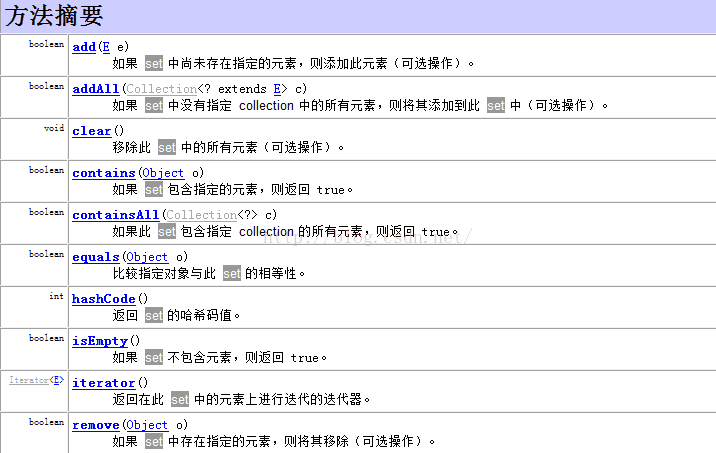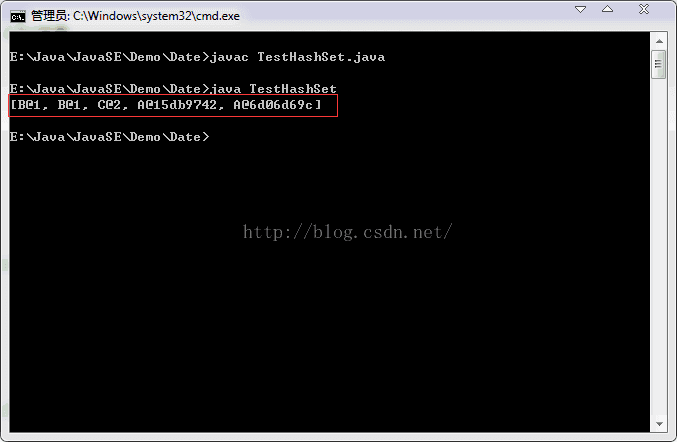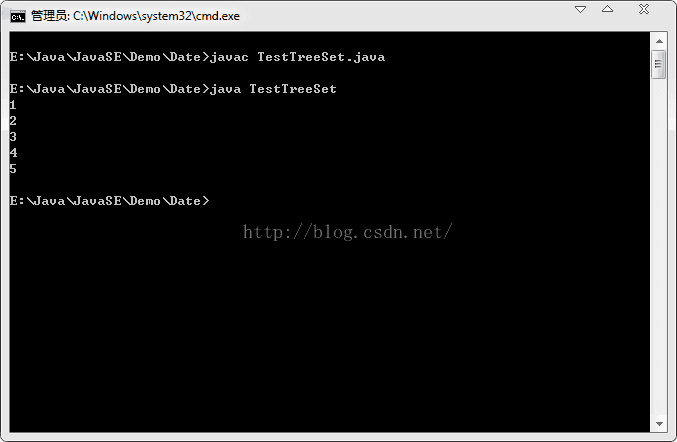JavaSE入门学习36:Java集合框架之Set接口及其实现类HashSet和TreeSet
一Set接口
Set接口可以与数学中的集合的概念相对应。Set接口是Collection接口的子接口,Set接口里多个对象之间没有明
显的顺序。具体详细方法请参考API文档(可见身边随时带上API文档有多重要),基本与Collection接口中定义的方法相
同。只是行为不同(Set不允许包含重复元素)。
Set集合不允许重复元素,是因为Set判断两个对象相同不是使用==运算符,而是根据equals()方法。即两个对象
用equals()方法比较返回true,Set就不能接受两个相等的对象。
我们来做个测试:
import java.util.*;
public class TestSet{
public static void main(String[] args){
Set books = new HashSet();
//添加一个字符串对象
books.add(new String("我是测试的对象"));
//再次添加一个字符串对象,
//因为两个字符串对象通过equals方法比较相等,所以添加失败,返回false
boolean result = books.add(new String("我是测试的对象"));
System.out.println(result);
//下面输出看到集合只有一个元素
System.out.println(books);
}
} 运行结果:
说明:程序中,book集合两次添加的字符串对象明显不是一个对象(程序通过new关键字来创建字符串对象),
当使用==运算符判断返回false,使用equals方法比较返回true,所以不能添加到Set集合中,最后只能输出一个元
素。
Set接口中定义的方法:
Set接口中的知识,同时也适用于HashSet、TreeSet等实现类。J2SDK API中所提供的Set接口实现类有
HashSet、TreeSet等,下面我们进行逐一介绍。
二实现类HashSet
HashSet(哈希集),是Set接口的一个重要实现类。HashSet使用的是相当复杂的方式来存储元素的,使用
HashSet能够最快的获取集合中的元素,效率非常高(以空间换时间)。会根据hashcode()方法和equals()方法来判
断是否是同一个对象,如果hashcode()方法一样,并且equals()方法返回true,则是同一个对象,不能重复存放。
HashSet实现类中定义的方法:
HashSet按Hash算法来存储集合的元素,因此具有很好的存取和查找性能。
HashSet的特点:
(1)HashSet不是同步的,多个线程访问是需要通过代码保证同步。
(2)集合元素值可以使null。
(3)HashSet集合判断两个元素相等的标准是两个对象通过equals()方法比较相等,并且两个对象的hashCode()方
法返回值也相等。
实例代码:
import java.util.*;
public class TestHashSet {
public static void main(String[] args){
Set运行结果:
说明:
(1)Object类提供的toString()方法总是返回该对象实现类的类名+@+hashCode(16进制数)值,所以可以看到上面
程序输出的结果。可以通过重写toString()方法来输出自己希望的形式。
(2)即使2个A对象通过equals()比较返回true,但HashSet依然把它们当成2个对象;即使2个B对象的hashCode()返
回相同值,但HashSet依然把它们当成2个对象。即如果把一个对象放入HashSet中时,如果重写该对象equals()方
法,也应该重写其hashCode()方法。其规则是:如果2个对象通过equals方法比较返回true时,这两个对象的
hashCode也应该相同。
知道了上面的方法,我们再来看看下面的实例:
import java.util.*;
public class TestHashSet {
public static void main(String[] args) {
Set set = new HashSet();
//添加两个相同的对象
Student s1 = new Student(1);
Student s2 = new Student(1);
Student s3 = new Student(2);
set.add(s1);
set.add(s2);
set.add(s3);
//遍历set中的对象
for (Student s : set) {
System.out.println(s);
}
}
}
class Student{
int id;
public Student(int id) {
this.id = id;
}
@Override
public String toString() {
return this.id+"";
}
@Override
public int hashCode() {
return this.id;
}
@Override
public boolean equals(Object obj) {
if (obj instanceof Student){
Student stu = (Student) obj;
if (stu.id == this.id)
return true;
}
return false;
}
} 运行结果:
正如上例所示,重写了hashCode()和equals()方法来区分同意对象后,就不能存放同以对象了。如果注释这两个
方法,则所有Student对象视为不同对象,都可以存放。
三实现类TreeSet
TreeSet也不能存放重复对象,但是TreeSet会自动排序,如果存放的对象不能排序则会报错,所以存放的对象
必须指定排序规则。
TreeSet实现类定义的方法:
排序规则包括自然排序和客户排序。
(1)自然排序:TreeSet要添加哪个对象就在哪个对象类上面实现java.lang.Comparable接口,并且重写
comparaTo()方法,返回0则表示是同一个对象,否则为不同对象。
(2)客户排序:建立一个第三方类并实现java.util.Comparator接口。并重写方法。定义集合形式为TreeSet ts =
new TreeSet(new 第三方类());
下面一个例子用TreeSet存放自然排序的对象:
import java.util.*;
public class TestTreeSet {
public static void main(String[] args) {
Set set = new TreeSet();
Student1 s1 = new Student1(5);
Student1 s2 = new Student1(1);
Student1 s3 = new Student1(2);
Student1 s4 = new Student1(4);
Student1 s5 = new Student1(3);
set.add(s1);
set.add(s2);
set.add(s3);
set.add(s4);
set.add(s5);
for (Student1 s : set) {
System.out.println(s);
}
}
}
class Student1 implements Comparable{
int id;
public Student1(int id) {
this.id = id;
}
@Override
public String toString() {
return this.id+"";
}
@Override
public int hashCode() {
return this.id;
}
@Override
public boolean equals(Object obj) {
if (obj instanceof Student1){
Student1 stu = (Student1) obj;
if (stu.id == this.id)
return true;
}
return false;
}
public int compareTo(Student1 o) {
return (this.id-o.id);
}
} 运行结果:
下面一个例子用TreeSet存放客户排序的对象:
import java.util.*;
public class TestTreeSet2 {
public static void main(String[] args) {
Set set = new TreeSet(new MySort());
Student2 s1 = new Student2(5);
Student2 s2 = new Student2(1);
Student2 s3 = new Student2(2);
Student2 s4 = new Student2(4);
Student2 s5 = new Student2(3);
set.add(s1);
set.add(s2);
set.add(s3);
set.add(s4);
set.add(s5);
for (Student2 s : set) {
System.out.println(s);
}
}
}
class MySort implements java.util.Comparator{
public int compare(Student2 o1, Student2 o2) {
return o2.id-o1.id;
}
}
class Student2{
int id;
public Student2(int id) {
this.id = id;
}
@Override
public String toString() {
return this.id+"";
}
@Override
public int hashCode() {
return this.id;
}
@Override
public boolean equals(Object obj) {
if (obj instanceof Student2){
Student2 stu = (Student2) obj;
if (stu.id == this.id)
return true;
}
return false;
}
} 运行结果:
说明:由运行结果可以看出,TreeSet并不是根据元素的插入顺序进行排序,而是根据元素实际值来进行排序。TreeSet采用红黑树的数据结构对元素进行排序,具体排序内容会在后续文章中说明。









